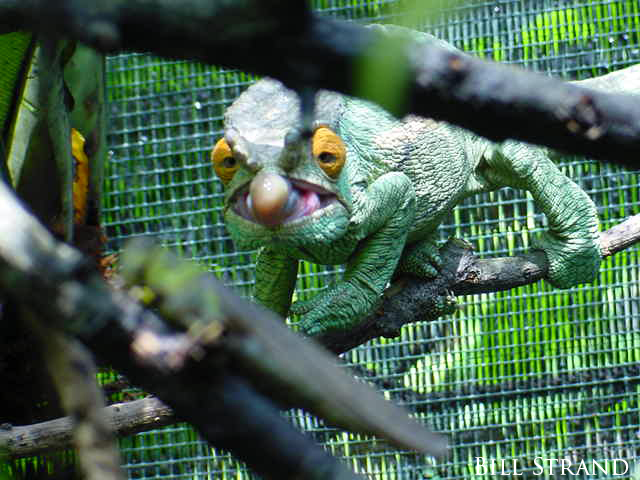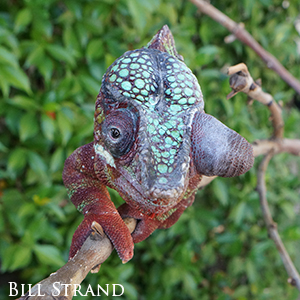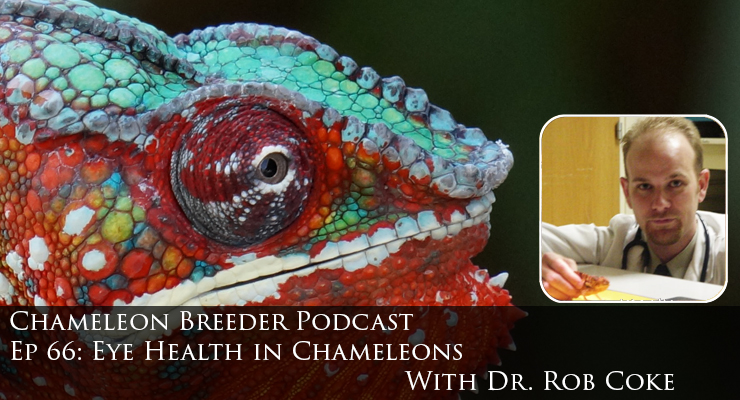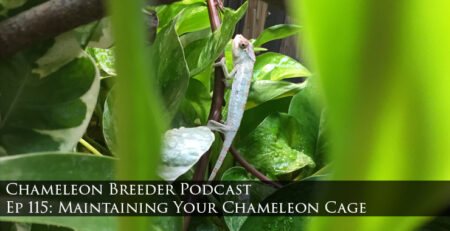Ep 66: Eye Health in Chameleons with Dr. Rob Coke
Introduction to Chameleon eyes
Chameleon’s eyes are nothing short of fantastic! But they also have a maintenance plan that needs to be followed for optimal health. In today’s episode, Dr. Rob Coke DVM and I discuss ocular health in chameleons.
The chameleon eye is a complicated structure which is designed to give chameleons the widest range view of their surroundings and to allow them that surgical strike of prey with their tongue. One of the most fascinating features of the chameleon’s eye is the ability to see in different directions independently!

As we humans well know, it is having two eyes looking at the same object that gives us our depth perception. And when it is time to shoot that long tongue out to get their next meal, chameleons zero in with both eyes!

Being a sophisticated structure, the chameleon eye is prone to having troubles. From bacterial infections to scratches, eye problems are a big deal to a chameleon. Without sight the chameleon does not eat. A chameleon’s eye should be bright and alert. Anytime a chameleon has its eye’s closed (and shouldn’t be sleeping) or has swelling it needs to be a trip to the veterinarian to get this taken care of immediately.


When a chameleon with an eye issue comes to Dr. Coke he will first examine the chameleon to try and determine the problem. One tool vets have is that they are able to put a harmless liquid in the eye which, when exposed to black light, will highlight scratches that may be causing the inflammation.

The standard method of cleaning a chameleon’s eye is to rinse it with saline and then apply an appropriate anti-biotic. The best way to ensure that the anti-biotic is the correct one is to culture the eye infection. If this cannot be done due to finances or the need for a timely treatment, the vet will select a “broad spectrum” anti-biotic which means it acts on a wide range of bacteria. Veterinarians are concerned about creating anti-biotic resistant bacteria so are careful to match the anti-biotic to the bacteria as closely and as often as possible.

The challenge is to flush out the eye of a chameleon that has no interest in having a human poke around its eye! To do a flush the veterinarian must have a steady hand and a firm grip so the chameleon will not get further damage in the treatment process.


What can we do to prevent chameleon eye issues?
Of course, the key in dealing with chameleon eye infections is to prevent them from happening in the first place. We cannot prevent every occurrence or mitigate every risk, but by giving chameleons proper husbandry you can reduce your health issues dramatically. In the case of eye health, our greatest husbandry issue is not allowing the chameleon to clean out its eyes. When it rains, chameleons are able to naturally wash out debris and built up “gunk” in their eyes. You may notice your chameleon during a long misting session drawing its eye in and rotating it about in its socket. It is unnerving when you first see it! But this is the chameleon maintaining its own eyes. So in captive husbandry it is critical that we provide a regular opportunity for this to occur. Regular rain sessions within the chameleon’s cage are the best approach. The most common method to achieve this is an automatic misting system. The next most often used method is weekly showers. Water is used for both hydration and hygiene. Drippers can hydrate, but will not allow the chameleon to clean their eyes. Chameleons take a while to settle in and start cleaning their eyes and this is the reason why hand misting usually is not an effective replacement for an automatic misting system. We just do not mist for long enough and even just our presence there may keep a chameleon from feeling safe enough to go through his entire self-clensing process.
In the chameleon community we constantly see new fads come and go. You will hear about alternative hydration methods including using water bowls, pipettes, fountains, and even keeping water from them because “they don’t get water every day in the wild”. As a keeper of a chameleon you must understand the needs of your chameleon. Chameleons have both hydration and hygiene needs and whatever new philosophy you decide to embrace, you must account for providing for both. Chameleons drink and clean themselves from rain showers. The further you get from rain showers the closer you get to the need for medical treatment.
Further education:
If you would like to learn more about issues surrounding eye problems and husbandry, check out these other two podcast episodes. The first is Dr. Coke talking about bacteria and helping us understand how it works. Bacterial infections are a common cause for chameleon eye problems and it is a good idea to understand it! Click below to listen in.
Hydration and Hygiene through proper water husbandry practices are discussed in the following episode. Click the picture to listen in.














